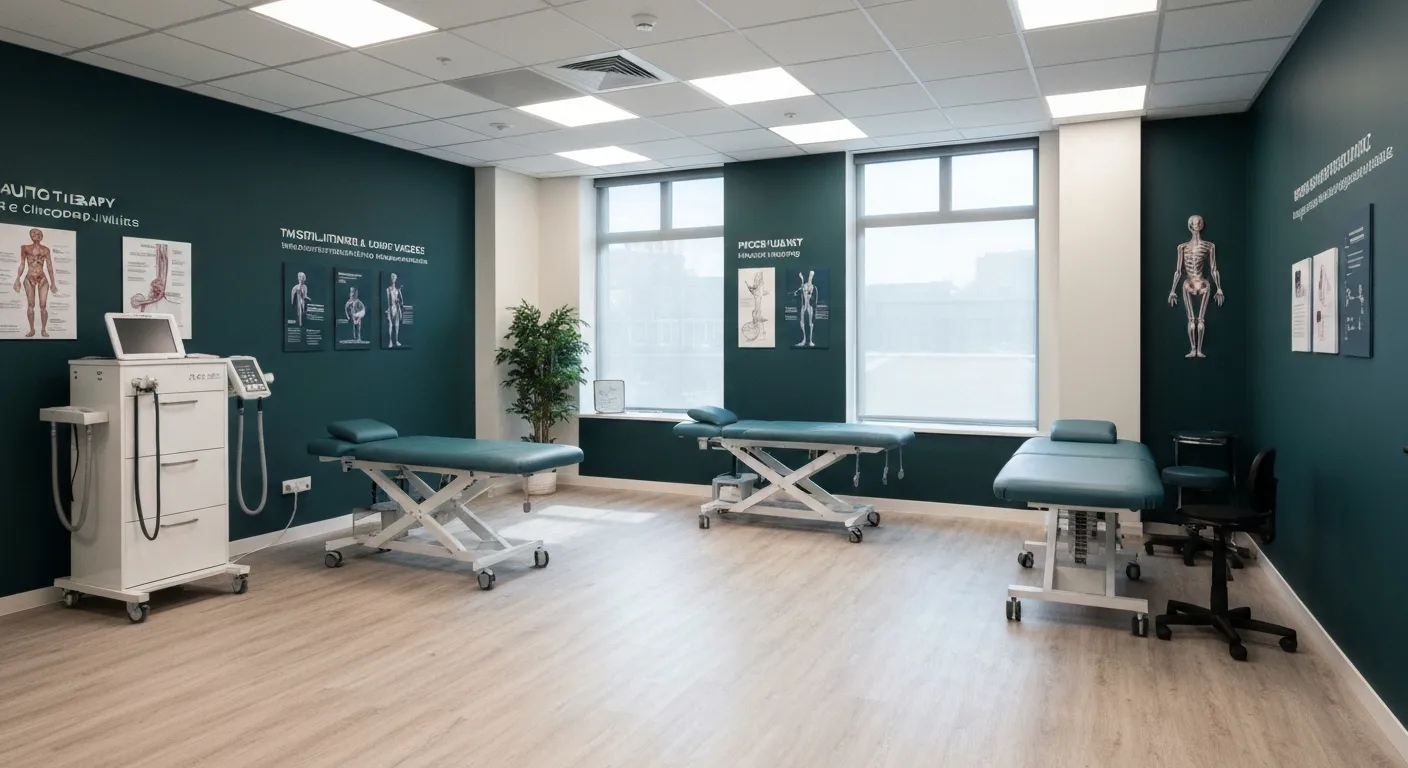Nutritional Strategies for Supporting Spine Health and Recovery
September 25, 2025
8 min

The Fundamental Role of Nutrition in Spine Health and Recovery
Maintaining a healthy spine is crucial for overall mobility and quality of life. While exercise and posture are well-known factors, nutrition plays an equally vital role in supporting spinal health, preventing injury, and enhancing recovery processes. This article explores evidence-based nutritional strategies designed to strengthen the spine, reduce inflammation, and accelerate healing after injury or surgery, offering practical guidance grounded in current scientific knowledge.
Essential Nutrients for Bone Strength and Spinal Integrity

What are the key nutrients and dietary practices that support spinal health and recovery?
Supporting spinal health and recovery depends on a balanced, nutrient-rich diet. Critical nutrients include calcium, vitamin D, magnesium, and vitamin K2, which work together to maintain strong bones and prevent conditions like osteoporosis.
Calcium is vital for bone density, especially in the spine. Food sources like dairy products, leafy greens, fish, beans, and nuts provide ample calcium. Vitamin D enhances calcium absorption in the intestines, with sun exposure, egg yolks, oily fish, and fortified foods being good sources.
Magnesium supports calcium absorption and helps keep bone tissue healthy. It can be found in spinach, seeds, nuts, and whole grains. Vitamin K2, often overlooked, plays a significant role in increasing bone density and reducing fracture risk by activating proteins involved in calcium binding. Fermented foods, certain cheeses, and meats provide vitamin K2.
In addition to these minerals and vitamins, protein intake is crucial for repairing tissues, especially after injury or surgery. Omega-3 fatty acids from fatty fish, walnuts, and flaxseeds help diminish inflammation, easing pain and supporting tissue healing. Antioxidants such as vitamins C and E, from fruits and vegetables, protect cells from oxidative stress and promote recovery.
Limiting processed foods high in sugars, saturated fats, trans fats, and excess caffeine supports overall spine health by reducing inflammation. Hydration, achieved through water intake, is essential for nutrient delivery, disc health, and joint lubrication.
Incorporating a diet with whole grains, lean proteins, colorful fruits, and vegetables maximizes nutritional benefits. Maintaining these dietary practices fosters stronger bones, reduces degeneration risk, and promotes spine healing, especially important after injuries or surgeries.
The Critical Role of Vitamins and Minerals in Spinal Recovery
What role do specific vitamins and minerals play in spinal recovery?
Vitamins and minerals are integral to the healing process after spinal injury or surgery. Calcium, vitamin D, and vitamin K are vital for maintaining and strengthening bone structure, which helps prevent fractures and supports stability in the spine.
Magnesium plays a couple of important roles—it not only supports proper muscle function and helps reduce muscle spasms but also facilitates nerve transmission, aiding in neural recovery. Vitamins C and E serve as antioxidants, which means they help neutralize harmful free radicals that cause oxidative stress, thus protecting spinal tissues from damage and promoting regeneration.
B vitamins, particularly B6 and B12, are critical for nerve health; they assist in nerve repair, reduce inflammation, and are involved in myelin formation. In addition, nutrients with anti-inflammatory properties, such as omega-3 fatty acids, support the reduction of inflammation in spinal tissues, improving mobility and decreasing pain.
Proper hydration is also crucial, as it helps transport these nutrients to tissues and maintains disc elasticity, facilitating ongoing repair processes. Altogether, these vitamins and minerals create a supportive environment that enhances tissue healing, strengthens bones, and promotes nerve regeneration, which are all essential for effective spinal recovery.
Evidence-Based Dietary Guidelines to Enhance Spinal Health

What evidence-based dietary guidelines can help improve spinal health?
Maintaining a balanced and nutrient-rich diet is vital for supporting spinal health. For individuals with spinal conditions or in recovery, focusing on specific nutrients can make a significant difference.
Essential nutrients such as calcium, vitamin D, magnesium, and vitamin K2 play critical roles in strengthening bones and reducing the risk of osteoporosis. Foods like dairy products, leafy greens, fatty fish, and fermented foods are excellent sources. Adequate calcium and vitamin D intake support bone density, which is crucial for spinal stability.
Adopting an anti-inflammatory dietary pattern, such as the Mediterranean diet, is highly beneficial. These diets emphasize omega-3 fatty acids from fish and nuts, vibrant fruits and vegetables rich in antioxidants, and whole grains. Such foods help reduce body and spinal inflammation, alleviating chronic back pain and supporting tissue repair.
It is equally important to limit foods that promote inflammation. These include saturated fats and trans fats found in red meat and processed snacks, excessive sugar, sodium, and fast food. Reducing intake of such foods can prevent worsening of inflammation and slow down degenerative processes.
Proper hydration, along with careful macronutrient distribution tailored to a person’s activity level and metabolic needs, supports healthy spinal tissues. Drinking sufficient water aids in nutrient transport, maintains disc elasticity, and lubricates joints.
Personalized nutritional assessments are essential. They help identify individual deficiencies or excesses and guide dietary adjustments to optimize spinal health.
Summary of Nutrients and Food Sources for Spinal Well-being:
| Nutrient | Role | Common Sources |
|---|---|---|
| Calcium | Bone strength | Dairy, leafy greens, fish, nuts |
| Vitamin D | Calcium absorption, bone health | Eggs, fortified foods, sunlight |
| Magnesium | Bone density, muscle function | Spinach, seeds, nuts, whole grains |
| Vitamin K2 | Bone mineralization | Fermented foods, cheeses |
| Omega-3 Fatty Acids | Reduce inflammation | Fatty fish, walnuts, flaxseeds |
| Antioxidants | Reduce oxidative stress | Fruits, vegetables, herbs |
In conclusion, evidence advocates for a holistic, nutrient-conscious approach combined with anti-inflammatory food patterns, hydration, and personalized assessment to bolster spinal health and prevent degeneration.
Nutrition's Role in Healing and Preventing Spinal Injuries

How can nutrition aid in the healing and prevention of spinal injuries?
Proper nutrition is fundamental in both recovering from spinal injuries and preventing future occurrences. Consuming adequate amounts of protein and specific nutrients supports tissue regeneration and muscle repair, which are vital after injury or surgery.
Important nutrients include vitamins C, D, E, and minerals such as calcium, zinc, and magnesium. Vitamin C is essential for collagen production, strengthening spinal discs and ligaments. Vitamin D facilitates calcium absorption, essential for maintaining bone density and preventing osteoporosis. Magnesium helps relax muscles and supports nerve function, reducing muscle spasms.
A nutrient-rich diet also plays a role in managing inflammation. Omega-3 fatty acids from fatty fish, walnuts, and flaxseeds possess anti-inflammatory properties that can reduce pain and swelling. Incorporating fruits and vegetables high in antioxidants, like berries and leafy greens, further helps combat oxidative stress and tissues damage.
Hydration is crucial during recovery. Drinking enough water facilitates nutrient transport, maintains disc elasticity, and supports joint lubrication. Adequate fiber intake ensures healthy bowel movements, especially important if medications cause constipation.
Limiting foods that increase inflammation, such as processed foods, refined sugars, trans fats, and excessive caffeine, is equally important. These foods can exacerbate swelling and slow healing.
In summary, a balanced diet supporting bone health, reducing inflammation, and maintaining overall tissue integrity is vital for optimal recovery from spinal injuries and for preventing future issues. Proper nutrition boosts the effectiveness of medical treatments and enhances long-term spinal health.
Incorporating Healthy Eating Habits to Enhance Spine Health

Eating the rainbow is a simple yet effective approach to promote spinal health. By consuming colorful fruits and vegetables, you maximize your intake of phytochemicals, antioxidants, and anti-inflammatory compounds. This vibrant variety helps combat oxidative stress, which can damage spinal tissues and accelerate degeneration.
Sources of antioxidant-rich foods include berries such as blueberries and cherries, leafy greens like spinach and kale, and bright vegetables including peppers and carrots. These foods provide vitamins C and E, which are essential for collagen production and cellular protection in discs and bones.
Hydration plays a crucial role in maintaining disc elasticity and joint lubrication. Drinking adequate water—about half your body weight in ounces daily—ensures proper nutrient transport throughout the spine. Proper hydration helps prevent disc dehydration and reduces stiffness, supporting overall spinal flexibility.
Avoiding pro-inflammatory foods and beverages is vital for spine health. Processed snacks, sugary drinks, excessive caffeine, alcohol, and foods high in trans fats and refined sugar promote inflammation, worsening conditions like disc degeneration and chronic back pain.
Instead, integrating anti-inflammatory spices and herbs such as turmeric, ginger, and rosemary can naturally reduce inflammation. These can be added to meals to enhance flavor and healing.
Combining these habits—richly colored foods, adequate hydration, and inflammation-reducing herbs—creates a nutritious foundation for spinal health. A balanced diet emphasizing healthy fats, lean proteins, and complex carbs further supports tissue repair and bone strength.
In sum, embracing a nutrient-dense diet that includes antioxidant-rich fruits and vegetables, plenty of water, and anti-inflammatory spices, while limiting harmful foods, can significantly enhance spine health and reduce the risk of degenerative conditions.
Scientific and Evidence-Based Nutrition Approaches for Spine Recovery

What scientific and evidence-based approaches exist regarding nutrition and spine recovery?
Research in the area of spine healing underscores the importance of a well-balanced, nutrient-dense diet that promotes tissue repair, decreases inflammation, and maintains bone integrity. Critical nutrients such as omega-3 fatty acids, vitamins D, E, B-complex, K2, calcium, magnesium, and zinc are associated with neural regeneration, bone healing, and immune system support.
In addition to individual nutrients, dietary patterns like the Mediterranean diet have been shown to positively influence inflammation levels and gut health, which are vital for effective recovery. Emerging evidence suggests that the gut microbiota—the community of microorganisms living in our intestines—plays a significant role in spinal cord injury recovery. Gut dysbiosis, or imbalance of these bacteria, can impair neuroregeneration and increase inflammation.
Enhancing the gut microbiota through increased intake of dietary fibers, prebiotics, and probiotics may help restore a healthy microbial balance. This, in turn, can support systemic healing and improve neurological outcomes.
Managing inflammation meaningfully impacts recovery. Consuming anti-inflammatory foods— such as fatty fish, berries, nuts, and spices like turmeric— while limiting processed foods, sugars, and saturated fats, can reduce chronic inflammation that hampers healing.
Personalized nutrition approaches are gaining traction, with considerations for an individual’s gut microbiota composition, the stage of injury, and metabolic needs. Tailoring diets to optimize nutrient absorption and inflammatory response can significantly improve rehabilitation outcomes.
Table 1 summarizes main dietary strategies:
| Strategy | Focus | Associated Benefits |
|---|---|---|
| Nutrient Optimization | Ensuring adequate intake of omega-3s, vitamins D, K2, calcium, magnesium | Supports neural repair, bone strength, immune response |
| Gut Microbiota Support | Increasing fiber, prebiotics, probiotics | Restores healthy bacteria, enhances systemic healing |
| Inflammation Management | Limiting processed foods, sugars, high-fat diets | Reduces chronic inflammation, speeds recovery |
| Personalized Diet Planning | Tailoring based on microbiota and metabolic needs | Maximizes individual recovery potential |
In conclusion, a scientifically-informed, comprehensive nutritional strategy—integrating nutrient adequacy, gut microbiota support, and inflammation control—is essential for optimizing spine recovery, especially when paired with appropriate medical and physical therapy interventions.
Integrating Nutrition into Comprehensive Spine Care
Optimal spine health and recovery extend beyond physical treatments to include tailored nutritional strategies that support bone strength, reduce inflammation, and promote tissue healing. By prioritizing a nutrient-rich, balanced diet with adequate hydration, and focusing on key vitamins and minerals, individuals can enhance spinal resilience and rehabilitation outcomes. Adopting anti-inflammatory foods while limiting harmful dietary factors further aids in pain management and long-term spinal integrity. Emerging scientific insights emphasize the importance of personalized nutrition and gut health in spine recovery, signaling promising pathways for future therapies. Embracing these evidence-based nutritional practices alongside lifestyle modifications can profoundly impact spinal wellness and recovery trajectories.
References
- Nutrition and the Spine
- Nutritional Strategies for Supporting Spinal Health
- Diet and nutrition for a healthy spine
- How Nutrition Improves Healing After Spine Surgery
- Boost Your Back Health with a Balanced Diet
- The Role of Nutrition in Brain and Spine Health
- Nutritional Strategies in the Rehabilitation ...
- Nutrition Strategies Fuel Recovery Following ...
- Building Strong Bones for a Healthy Spine: Key Nutritional ...
- Role of Nutrition in Spine Rehab: Fueling Your Recovery
Recent articles

Chiropractic Methods That Provide Lasting Relief from Back Pain

Understanding Spinal Decompression and Its Benefits for Sciatica

Real Patient Testimonials: Success Stories in Chiropractic Care

Top Questions to Ask Your Chiropractor During Your Initial Visit

Physiotherapy's Role in Supporting Chiropractic Treatment Plans

The Role of Diet and Nutrition in Enhancing Wellness and Chiropractic Care

Inspiring Patient Testimonials Highlighting Chiropractic Success

Chiropractic Care: A Natural Solution for Back Pain Relief

Amazing Patient Success Stories in Chiropractic Wellness

Combining Physiotherapy and Chiropractic for Optimal Healing

Spinal Decompression Therapy: A Breakthrough for Sciatica Sufferers

5 Holistic Treatments That Complement Chiropractic Care

How Physiotherapy Supports and Enhances Chiropractic Treatment

Root Cause Versus Symptom Treatment: Making the Right Choice

7 Essential Things to Know Before Choosing Your Chiropractor

Why Addressing Root Causes of Pain Matters More Than Just Symptoms

Nutritional Counseling Strategies to Boost Your Overall Wellness

How Spinal Decompression Therapy Alleviates Sciatic Nerve Pain

Long-Term Pain Relief Through Targeted Corrective Exercises

10 Benefits of Integrating Physiotherapy with Chiropractic Treatments

Corrective Exercises That Help Prevent Recurring Pain

8 Corrective Exercises Proven for Lasting Pain Relief

Lifestyle Habits for Maintaining a Healthy Spine

What You Will Experience at Your Initial Chiropractic Visit

What Happens at Your First Visit to a Chiropractor?

Focusing on Root Cause Analysis for Effective Pain Relief

Tips for Lifestyle Changes to Support Spinal Health

Tips for Lifestyle Changes to Support Spinal Health

Holistic Treatment Plans: Alternatives to Surgery for Chronic Pain

Enhance Wellness Through Personalized Nutritional Counseling

Non-Invasive Pain Relief: Exploring Holistic Treatment Alternatives

Sciatica Relief Through Targeted Spinal Decompression

Integrating Physiotherapy with Chiropractic Treatments for Better Results

Testimonials That Demonstrate the Benefits of Chiropractic Care

The Power of Corrective Exercises in Pain Management

A Step-by-Step Guide to Your Initial Chiropractic Consultation

9 Nutritional Tips to Enhance Your Chiropractic Wellness Journey

Patient Experiences: How Chiropractic Care Changed Their Lives

Lifestyle Recommendations to Keep Your Spine in Top Shape

Effective Corrective Exercises for Long-Term Pain Relief

Back Pain Benefits: What Chiropractic Care Can Do for You

Spinal Decompression Techniques for Effective Sciatica Relief

Top Nutritional Counseling Tips for Enhanced Wellness

6 Lifestyle Habits That Boost Spine Health Daily

Discover Holistic and Non-Surgical Pain Relief Solutions

Exploring Holistic and Non-Surgical Treatment Options for Pain

The Role of Physiotherapy in Enhancing Chiropractic Care Outcomes

Complementing Chiropractic Care with Physiotherapy: What You Need to Know

What to Expect During Your First Chiropractic Visit

Simple Lifestyle Adjustments to Maintain a Healthy Spine

Personalized Nutritional Counseling for Improved Health Outcomes

Exploring Non-Surgical Treatments for Spine-Related Conditions

An Introduction to Spinal Decompression for Sciatica Patients

Transformative Success Stories: Patient Experiences with Chiropractic Treatments

Why Chiropractic Care Is Essential for Back Pain Relief

Addressing Underlying Causes Versus Symptom Management in Pain Care

The Role of Nutrition in Enhancing Chiropractic Treatment Effectiveness

Sciatica Treatment Options: Is Spinal Decompression Right for You?

Lifestyle Tips to Maintain a Healthy Spine and Prevent Back Issues

The Synergy Between Physiotherapy and Chiropractic Treatments

What Happens During Your Initial Chiropractic Consultation

Effective Corrective Exercises for Sustainable Pain Management

Taking a Root Cause Approach to Chronic Pain Management

Holistic Pain Management Techniques Without Surgery

How Patient Success Stories Validate Chiropractic Care Benefits

Spinal Decompression: Innovative Treatment for Sciatic Nerve Pain

Spinal Decompression Therapy: A Non-Invasive Approach to Sciatica Relief

Exploring Holistic Approaches Beyond Surgery for Pain Relief

Practical Lifestyle Advice to Support a Healthy Spine Every Day

Corrective Exercise Routines Designed for Long-Term Pain Prevention

Real Patient Stories: Overcoming Chronic Pain with Chiropractic Care

Lifestyle Changes That Promote a Healthy Spine and Prevent Injury

How Addressing the Root Cause of Pain Leads to Lasting Relief

Non-Surgical Holistic Therapies to Manage Chronic Pain Effectively

Nutritional Counseling's Impact on Physical Health and Healing

Benefits of Regular Chiropractic Care for a Stronger Back

Your First Chiropractic Visit: What to Expect and How to Prepare

Patient Experiences: How Chiropractic Care Transformed Their Lives

Exploring Holistic, Non-Surgical Options for Pain Management

Combining Physiotherapy with Chiropractic Treatments for Enhanced Recovery

Holistic Treatments That Offer Alternatives to Surgery for Pain Relief

Corrective Exercise Strategies for Long-Term Spine Health

How Physiotherapy Complements Chiropractic Adjustments for Better Outcomes

First-Time Chiropractic Visitors: What You Should Know

Understanding the Importance of Treating Pain at Its Source

Adopting Lifestyle Changes to Support Your Spine's Wellness

Utilizing Physiotherapy to Enhance Chiropractic Treatment Outcomes

The Key Advantages of Chiropractic Care for Back Pain Sufferers

Why Focusing on Root Causes Improves Pain Treatment Success

Corrective Exercises That Promote Lasting Pain Relief and Mobility

Sciatica Relief Through Targeted Spinal Decompression Techniques

Preparing for Your First Chiropractic Appointment with Confidence

Healthy Lifestyle Habits for Maintaining Spinal Alignment

Success Stories Highlighting Chiropractic's Role in Pain Recovery

Top Benefits of Chiropractic Care for Chronic Back Pain

Nutrition Tips to Boost Your Overall Wellness and Recovery

How Chiropractic Care Alleviates Back Pain Naturally

How Nutritional Counseling Supports Overall Wellness and Spine Health

Step-by-Step Guide to Your First Visit with a Chiropractor

